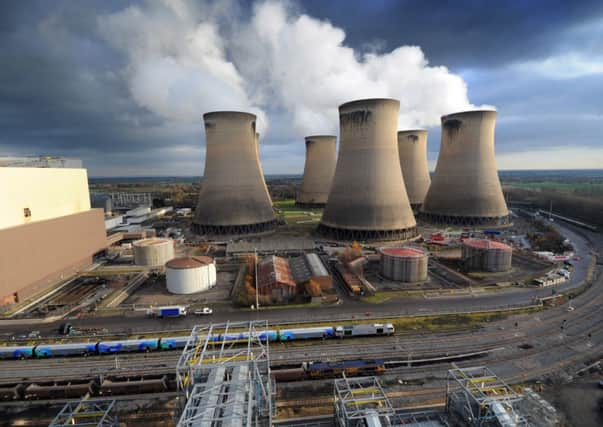Profits take a tumble but Drax forecasts a sustainable future


The power station, near Selby in North Yorkshire, converted its first unit to biomass last April and said the operating performance had surpassed its expecta- tions.
It now expects output of 630MW from the unit, which means it is only 0.5 per cent less efficient than coal.
Advertisement
Hide AdAdvertisement
Hide AdDrax’s chief executive Dorothy Thompson said: “We did work across every aspect to see how we could improve and we identified a number of areas where we could improve output and efficiency.
“It’s all about getting the fuel delivery right, the airflow right and the right heat balance to make the turbines more efficient.”
She said that, as expected, the increasing cost of carbon drove earnings down year on year.
“Recognising this, we have been investing significant capital to transform Drax into one of the world’s largest renewable generators burning sustainable biomass,” she said.
Advertisement
Hide AdAdvertisement
Hide AdThe group aims to convert its second unit to biomass by April 2015 and its third by the fourth quarter of 2015 at the earliest.
“In 2016, we expect half of Drax to be fuelled by sustainable biomass, some four per cent of the UK’s electricity,” said Ms Thompson.
“In delivering this transformation, we will provide cost-effective, reliable renewable power to consumers, secure jobs at Drax and across the UK supply chain and deliver attractive returns for our investors.”
The company said earnings before interest, tax, depreciation, amortisation and unrealised gains or losses on derivative contracts (EBITDA) were ahead of market estimates, but fell 23 per cent to £230m in the year to December 31 due to rising carbon costs.
Advertisement
Hide AdAdvertisement
Hide AdEarnings fell from £298m in 2012 reflecting the increasing costs of carbon at £120m, driven by the introduction of the UK government’s carbon price support mechanism from April 1 and the removal of free allowances.
Analysts were expecting EBITDA of £221.52m.
Jonathan Jackson, head of equities at Killik & Co, said: “EBITDA came in ahead of consensus, albeit down 23 per cent year-on-year to £230m, reflecting healthy spreads and a strong operational performance, which were offset by higher carbon costs.
“A second unit will be converted to biomass in mid-2014, with a third unit expected in the final quarter of 2015 rather than in 2016 as previously guided.
“Studies are now continuing on a fourth unit that could be converted in 2016.
Advertisement
Hide AdAdvertisement
Hide Ad“The balance sheet remains strong, with net cash of £71m, although with continued investment in management’s transformation project towards biomass, the group remains committed to optimising its capital structure.”
The group cut its full-year dividend by 30 per cent, to 17.6p, slightly ahead of consensus.
Work has started on the construction of a wood pellet plant and port facilities in the US, which Ms Thompson described as an important part of the group’s business model.
“They help us to optimise the biomass supply chain from North America which is still in its infancy, but is the main source of sustainable biomass fuel,” she said.
Advertisement
Hide AdAdvertisement
Hide AdShe added that there has been progress on the construction of two 450 thousand tonnes per annum wood pellet plants in Mississippi and Louisiana, and on a port facility at Baton Rouge in Louisiana.
“All three construction projects are progressing to schedule and budget,” she said.
“We are targeting the first quarter of 2015 for the start of commercial operations at Amite and Baton Rouge and the second quarter for Morehouse, with full capacity reached six months later.”
She said that sustainability is critical to the group’s biomass strategy.
Advertisement
Hide AdAdvertisement
Hide Ad“All our biomass, whether in raw fibre or pellet form is procured against our own robust sustainability criteria,” she said.
“These include requirements for high greenhouse gas emission reduction and habitats and biodiversity protection, as well as due consideration for the important socio-economic factors in the source areas.”
Drax said its calculations show that the range of sustainable biomass materials it has burnt over the last few years has a low carbon footprint.
In 2013, the average greenhouse gas emissions were significantly below the Government maximum for biomass. These are expected to become mandatory in 2015.